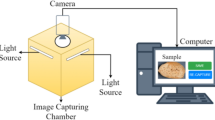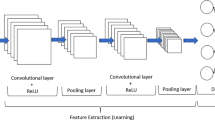Abstract
Plants and trees are essential for the human kind which must be preserved and well taken care for the growth of any country. Plants require intensive care which involves monitoring of their size, growth, health, and yield. Manually monitoring of these factors is time consuming. In this regard, computer vision approaches are evolving to monitor the plants for developing better yields. Deep learning convolution neural network is the most promising and currently trending tool which can solve the complex problems in the field of image processing and computer vision. However, often these deep learning models are computationally expensive and time-consuming which makes them unsuitable to be used in the real world scenarios. Thus, a lightweight deep learning convolutional neural network was designed and proposed to automatically segment the plant’s leaves so that the monitoring of the plants can be done with high speed. Benchmark datasets in four different categories with total of 810 images were collected to train and test the proposed model. Many challenges were associated with those categories under the mentioned dataset for the segmentation of leaves. The proposed light-weight deep learning model was implemented on MATLAB platform tool and trained on a local system without using any GPU (Graphical Processing Unit). The training was completed within 13 minutes and 25 sec and provided segmentation accuracy on testing set as 98.26% which is satisfactory for such kind of monitoring applications.





Similar content being viewed by others
Data availability
The benchmarked dataset was used in the study which is available at the given source/reference.
References
Alguliyev R, Imamverdiyev Y, Sukhostat L, Bayramov R (2021) Plant disease detection based on a deep model. Soft Comput 25:13229–13242
Al-Shakarji NM, Kassim YM, Palaniappan K (2017) Unsupervised Learning Method for Plant and Leaf Segmentation. in 2017 IEEE Appl Imag Pattern Recognit Workshop (AIPR)
Ashok M, Gupta A (2021) A systematic review of the techniques for the automatic Segmentation of organs-at-risk in thoracic computed tomography images. Archives Comput Methods Eng 28(4):3245–3267
Ashok M, Gupta A (2021) Deep learning-based techniques for the automatic segmentation of organs in thoracic computed tomography images: A Comparative study. in Proceedings - International Conference on Artificial Intelligence and Smart Systems, ICAIS 2021
Bao W, Fan T, Hu G, Liang D, Li H (2022) Detection and identification of tea leaf diseases based on AX-RetinaNet. Sci Rep 12(1):2183
Bell J, Dee HM (2019) Leaf segmentation through the classification of edges. ArXiv, 2019. abs/1904.03124
Boulent J, Foucher S, Théau J, St-Charles PL (2019) Convolutional Neural Networks for the Automatic Identification of Plant Diseases. Front Plant Sci, 10(941)
Cap HQ, et al. (2018) A deep learning approach for on-site plant leaf detection. in 2018 IEEE 14th International Colloquium on Signal Processing & Its Applications (CSPA)
Dellen B, Scharr H, Torras C (2015) Growth signatures of rosette plants from time-lapse video. IEEE/ACM Trans Comput Biol Bioinforma 12(6):1470–1478
Gai J, Tang L, Steward BL (2020) Automated crop plant detection based on the fusion of color and depth images for robotic weed control. J Field Robot 37(1):35–52
Gao L, Lin X (2019) Fully automatic segmentation method for medicinal plant leaf images in complex background. Comput Electron Agric 164:104924
Gopi ES (2021) An hierarchical approach for automatic segmentation of leaf images with similar background using kernel smoothing based Gaussian process regression. Ecol Inf 63:101323
Gupta A (2019) Current research opportunities of image processing and computer vision. Comput Sci; Vol 20, No 4, https://doi.org/10.7494/csci.2019.20.4.3163
Gupta A, Prakash D (2020) A fast and efficient color model for automatic monitoring of plants based on LEAF images. J Crit Rev 7(17):2398–2404
Gupta RK, Sahu Y, Kunhare N, Gupta A, Prakash D (2021) Deep learning based mathematical model for feature extraction to detect Corona virus disease using chest X-ray images. Int J Uncertain Fuzziness Knowl-Based Syst 29(06):921–947
Huang W, Guan Q, Luo J, Zhang J, Zhao J, Liang D, Huang L, Zhang D (2014) New optimized spectral indices for identifying and monitoring winter wheat diseases. IEEE J Select Topics Appl Earth Observ Remote Sens 7(6):2516–2524
Huixian J (2020) The analysis of plants image recognition based on deep learning and artificial neural network. IEEE Access 8:68828–68841
Jadhav SB, Udupi VR, Patil SB (2019) Convolutional neural networks for leaf image-based plant disease classification. IAES Int J Artif Intell (IJ-AI) 8(4):328–341
Kolhar S, Jagtap J (2021) Convolutional neural network based encoder-decoder architectures for semantic segmentation of plants. Ecol Inf 64:101373
Kumar N et al (2012) Leafsnap: A Computer Vision System for Automatic Plant Species Identification. Springer Berlin Heidelberg, Berlin, Heidelberg
Minervini M, Abdelsamea MM, Tsaftaris SA (2014) Image-based plant phenotyping with incremental learning and active contours. Ecol Inf 23:35–48
Ozturk S, Akdemir B (2017) Automatic leaf segmentation using grey wolf optimizer based neural network. in 2017 Electronics
Pandey M, Gupta A (2021) A systematic review of the automatic kidney segmentation methods in abdominal images. Biocybernetics Biomed Eng 41(4):1601–1628
Patil BM, Burkpalli V (2022) Segmentation of cotton leaf images using a modified chan vese method. Multimed Tools Appl 81:15419–15437
Praveen Kumar, J. And S. Domnic, Image based leaf segmentation and counting in rosette plants. Inform Process Agric, 2019. 6(2): p. 233–246.
Raina S, Gupta A (2021) A Study on Various Techniques for Plant Leaf Disease Detection Using Leaf Image. in Proceedings - International Conference on Artificial Intelligence and Smart Systems, ICAIS 2021
Raza S-E-A et al (2015) Automatic Detection of Diseased Tomato Plants Using Thermal and Stereo Visible Light Images. Plos One 10(4):e0123262
Rzanny M, Mäder P, Deggelmann A, Chen M, Wäldchen J (2019) Flowers, leaves or both? How to obtain suitable images for automated plant identification. Plant Methods 15(1):77
Scharr H, et al. (2014) Annotated image datasets of rosette plants, in In European Conference on Computer Vision. p. 1–16
Semantic segmentation quality metrics – MATLAB. Mathworks.com (2021) https://www.mathworks.com/help/vision/ref/semanticsegmentationmetrics.html
Sharma S, Gupta A (2020) A review for the automatic methods of plant's leaf image segmentation. Int J Intell Sustain Comput 1(1):101–114
Triki A, Bouaziz B, Gaikwad J, Mahdi W (2021) Deep leaf: mask R-CNN based leaf detection and segmentation from digitized herbarium specimen images. Pattern Recogn Lett 150:76–83
Trivedi M, Gupta A (2021) Automatic monitoring of the growth of plants using deep learning-based leaf segmentation. Int J Appl Sci Eng 18(2):1–9
Trivedi M, Gupta A (2021) A lightweight deep learning architecture for the automatic detection of pneumonia using chest X-ray images. Multimed Tools Appl 81:5515–5536
Viaud G, Loudet O, Cournède P-H, Leaf Segmentation and Tracking in Arabidopsis thaliana Combined to an Organ-Scale Plant Model for Genotypic Differentiation (2017) Front Plant Sci, 7(2057), Leaf Segmentation and Tracking in Arabidopsis thaliana Combined to an Organ-Scale Plant Model for Genotypic Differentiation
Wäldchen J, Rzanny M, Seeland M, Mäder P (2018) Automated plant species identification—trends and future directions. PLoS Comput Biol 14(4):e1005993
Xie X, Ma Y, Liu B, He J, Li S, Wang H (2020) A Deep-Learning-Based Real-Time Detector for Grape Leaf Diseases Using Improved Convolutional Neural Networks. Front Plant Sci. 11(751)
Yang K, Zhong W, Li F (2020) Leaf Segmentation and classification with a complicated background using deep learning. Agronomy 10(11):1721
Yin X, Liu X, Chen J, Kramer DM (2018) Joint multi-leaf Segmentation, alignment, and tracking for fluorescence plant videos. IEEE Trans Pattern Anal Mach Intell 40(6):1411–1423
Funding
The study was supported by grant No. F.30–436/2018(BSR) and RP-103 received from UGC (University Grants Commission), India.
Author information
Authors and Affiliations
Contributions
The corresponding author has contributed for this manuscript.
Corresponding author
Ethics declarations
Competing interests
The author declares that they have no conflicts of interest.
Additional information
Publisher’s note
Springer Nature remains neutral with regard to jurisdictional claims in published maps and institutional affiliations.
Rights and permissions
Springer Nature or its licensor holds exclusive rights to this article under a publishing agreement with the author(s) or other rightsholder(s); author self-archiving of the accepted manuscript version of this article is solely governed by the terms of such publishing agreement and applicable law.
About this article
Cite this article
Gupta, A. A lightweight deep neural network implemented on MATLAB without using GPU for the automatic monitoring of the plants. Multimed Tools Appl 82, 7343–7359 (2023). https://doi.org/10.1007/s11042-022-13678-2
Received:
Revised:
Accepted:
Published:
Issue Date:
DOI: https://doi.org/10.1007/s11042-022-13678-2




